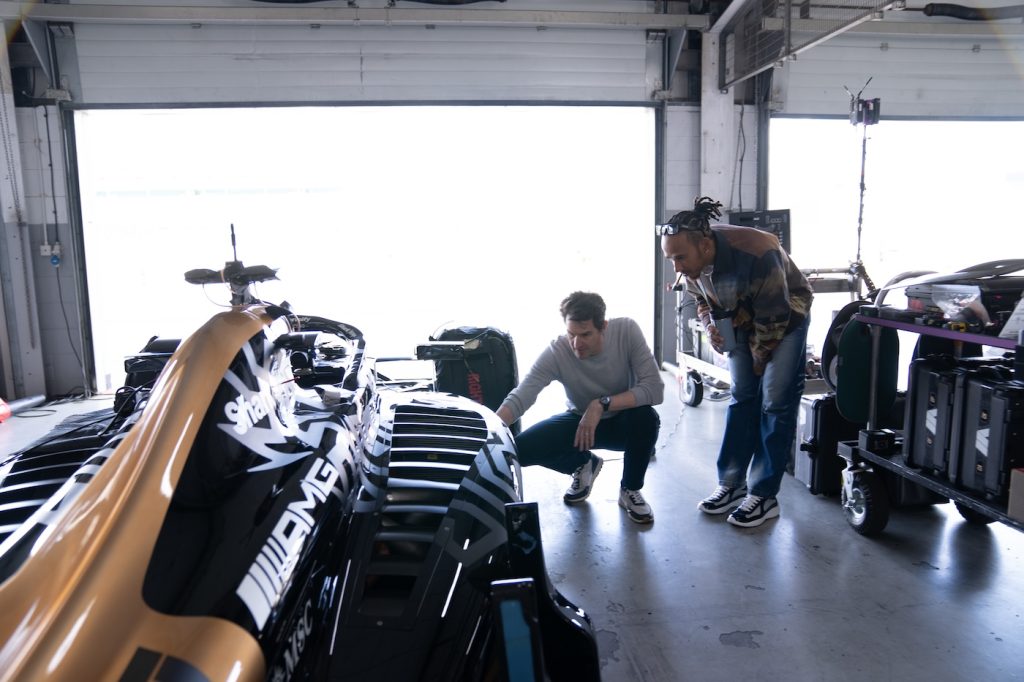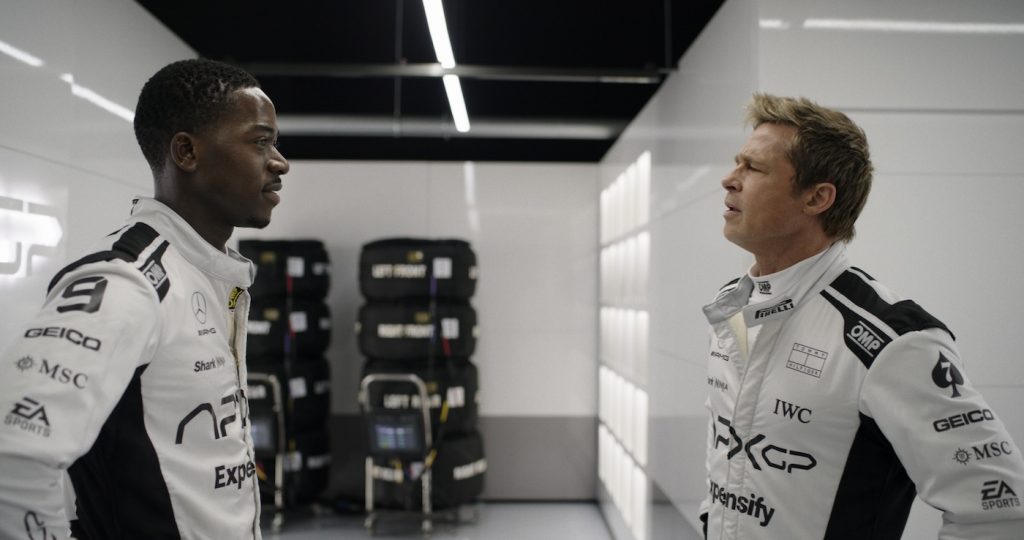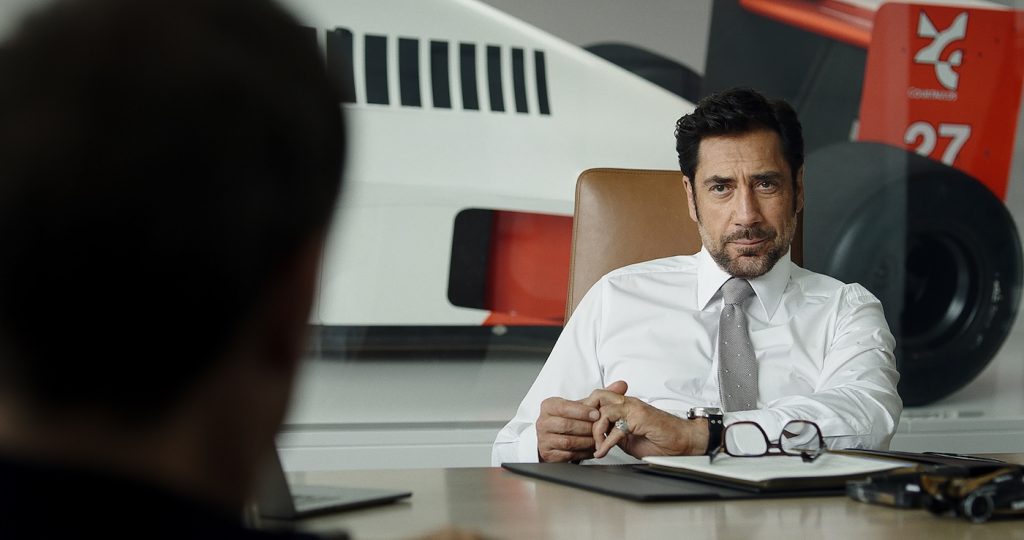How “F1” Production Designer Ben Munro Built Real Racing Garages That Traveled the World
Architect-turned-director Joseph Kosinski knows how to build action movies modeled, more than most, on analog reality. Following on Top Gun: Maverick, Kosinski has re-teamed with producer Jerry Bruckheimer to put Brad Pitt in the driver’s seat for F-1 (now in theaters). The filmmakers, deploying cinematographer Claudio Miranda’s ingenious camera rigs, worked with producer/ex-driver James Lewis to secure cooperation from the Formula One organization so that Pitt and co-star Damon Idris could get behind the wheels of real cars in front of actual crowds and speed down raceways in UK, Hungary, Belgium, Italy, Netherlands, Japan, Mexico City and Abu Dhabi at 200 miles an hour.
Production designers Mark Tildesley and Ben Munro, who previously art-directed Napoleon, Dumbo, and Prometheus, adhered to a single mantra throughout the making of F-1. “At the start of prep,” Munro recalls, “Joe and Jerry were adamant that the film be as authentic as possible, so we had to really be there at the races rather than creating virtual environments through VFX – we had no interest in that.”
Speaking from his home in London, Munroe discusses building a pit stop that really works, drawing inspiration from Mercedes’ sleek headquarters and incorporating Brad Pitt’s favorite color into the F-1 palette.
Brad Pitt’s Sonny character starts off as this free-spirited dude who’s living in a van and racing cars at Daytona Beach when he feels like it. How did you conceptualize his funky living space on wheels?
Joe wanted Sonny to have this nomadic lifestyle, someone who doesn’t want to be tied down. The easiest way to show that is by showing him living in an RV. There are many levels of RV, from the humblest to those that are singing and dancing. Ford Econolines were quite popular in the seventies when people were sort of — pimping is the wrong word — but changing the suspension and putting big wheels so you could drive off-road to beaches and mountains. The Econoline we found was mustard yellow. We painted it this sort of muted green, which you see throughout the movie. That’s really for Brad because green is his favorite color. It’s on Sonny’s helmet, it’s in the RV, and it’s in the truck stop shower. At the London premiere for F-1, Brad’s wearing a green suit.
So, funky green on the outside…
And we redid the interior, changed out the vinyl, installed curtains, and dressed the RV to tell the story of Sonny’s past. Stickers, racing ID lanyards, and a photo of his dad, which warrants a close-up. All of that basically gives you a sense of where Sonny’s coming from and where he’s at now in his headspace.
Then Javier Bardem’s Ruben character, head of the Apex racing team, convinces Brad/Sonny to compete in Formula One racing, which is presented in pristine detail. Before you signed on to design F-1, what, if anything, did you know about Formula One racing?
As a kid, I loved watching Formula One on TV, with all these great drivers like Nigel Mansell, [Ayrton] Senna, and Michael Schumacher. Years passed, and then you get the call to work on F-1, and you say, “Okay, I think I know a lot about it.” And then you get into the research and realize “I don’t know anything at all. I don’t know anything!” [laughing].
How did you learn?
We had extraordinary access to different teams. We went to McLaren, Aston Martin, and Mercedes, which was our primary point of contact because of our connection with F-1 driver Lewis Hamilton [who later moved to Ferrari]. If a mechanic walked into our garage and opened a drawer, we had to make sure the tools in that drawer were the right tools for the job. We had to know that the screen graphics were the correct screen graphics. The pit gantry outside the garage, which has the air lines on it so you can change the tires, that has to really work. Even though it’s a film set, the garage had to operate like a real garage.

To immerse the audience in these races, you embedded your garages in competitions throughout Europe. How did you manage that logistically?
We constructed two identical garages that had to go to these various locations on a truck, or by sea freight, or by air freight. That means when we broke down the sets, they had to fit into certain boxes. When the garage was sea-freighted to Abu Dhabi, for example, we had to make sure the garage fit into the sea freight boxes. There’s a Spanish architect named Santiago Calatrava, and he was the inspiration for our garage, the shape of the central console that goes arching in a beautiful way.
So it’s not enough to build the garage. You had to take it apart, put it together, take it apart, and put it together again and again.
We had to break down the garage set into sectional pieces that could be dismantled and reassembled quickly. Our first installation at Silverstone [race in England], we were the rookie team in the F-1 world, so we decided to give ourselves a little padding: “We’re going to build this in three weeks.” By the end of the movie, we got it down to one week. Just like an F-1 team, as you fine-tune things, all the departments get more efficient.
It’s pretty amazing that the Formula One organization allocated a space along the track for you filmmakers to set up a pit stop garage alongside all the other actual competitors.
Hats off to Jerry Bruckheimer. The test for us came at Silverstone. Everyone was blown away by how realistic it was to the point that Jackie Stewart walked into the garage wearing all his tartan, as he likes to do, and told me that in the 60 years he’s been doing Formula One, this is the most stylish garage he’s ever been in. That was a pinch-yourself moment.

Apex headquarters, in contrast to Brad’s funky Econoline, is sleek, gleaming, minimalist, and white. What was your inspiration for the corporate space?
Joe and I investigated the notion of building our own totally fictional headquarters, but then we started going around to these places and decided to showcase the best of what these F1 headquarters had to offer. The McLaren office was designed by [Pritzker Prize-winning architect] Norman Foster. Joe’s a trained architect, so he’s like, “Wow, that’s such a cool building.” We went to Mercedes. Inside, it’s super white, super slick, in line with our garage. Okay, that’s cool. Then we went to Williams and they had this wild wind tunnel, which was interesting because it had a bright red light that came on, cancels out the laser, and keeps you from being blinded.

So you cherry-picked specific qualities from each of these spaces and stitched together this hybrid Apex headquarters with the sleek white vibe.
We just used different things from each place that fit the story. For example, you talk about white – it’s actually called Traffic White, funnily enough. Off white, actually, but looks white on camera.
How did the white help serve the visual storytelling?
The car is a character in its own right in the film, so we wanted to showcase it to the best of our ability, along with our actors. Having this sort of clinical white backdrop allowed every other thing [in the foreground] to pop and sing, without clashing.

And, of course, you obtained permission to enter these spaces with the film crew. Secretive?
So, as it often happens in film, you have planning and design, and then you have a little stroke of luck. All these things kind of slotted together, and Joe was keen on including the real teams in the film, so, once it became apparent that we could use these different areas from the different headquarters, it seemed like a good thing to do.
It sounds like you understood that old expression: “Don’t look a gift horse in the mouth.” If the actual environments you needed were yours for the asking, why try to make stuff up from scratch?
And it goes back to this word, authentic. If you’re aiming to be truly authentic, there’s nothing more authentic than using the real place.
Featured image: Caption: BRAD PITT as Sonny Hayes in Apple Original Films’ “F1® The Movie,” a Warner Bros. Pictures release. Photo Credit: Photo by Scott Garfield Courtesy Warner Bros. Pictures / Apple Original Films



